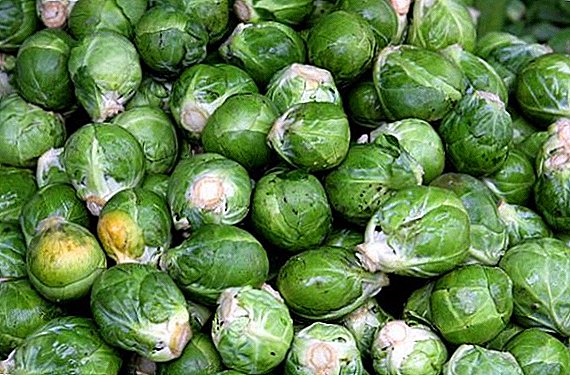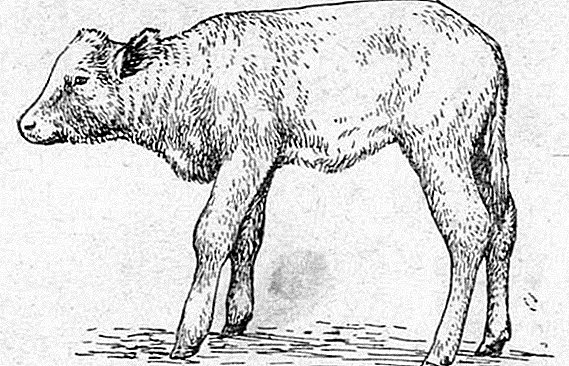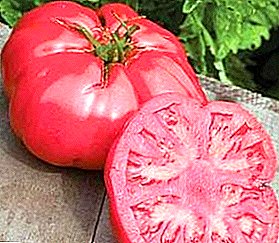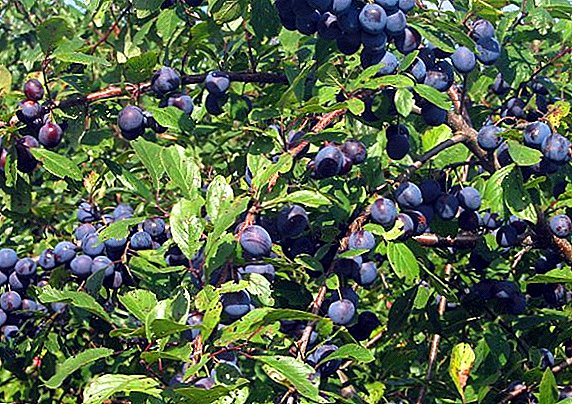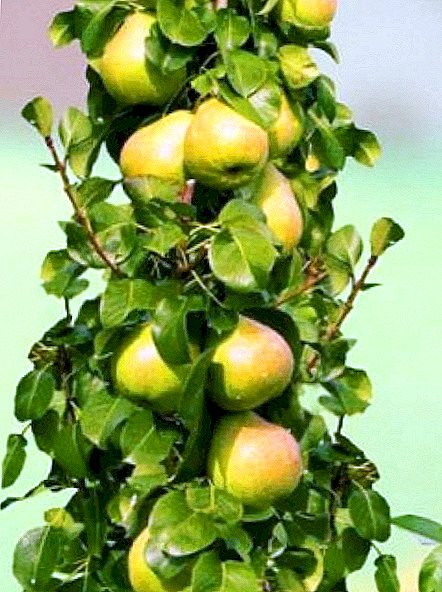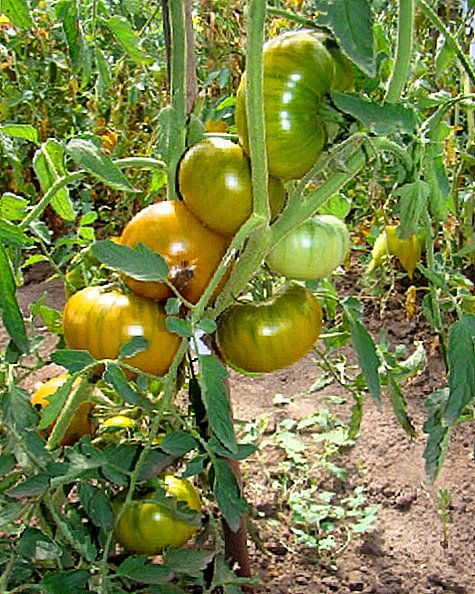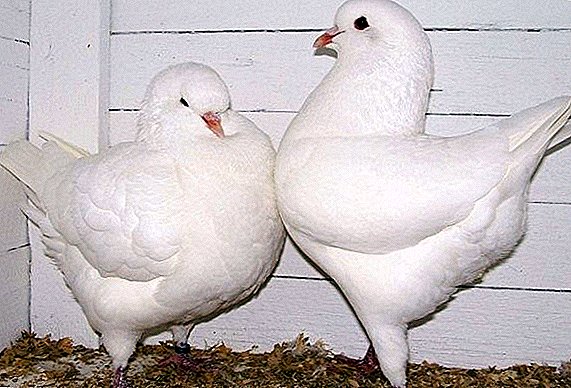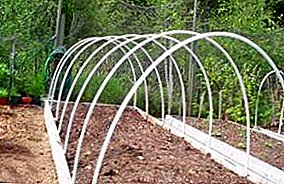 Oak has long been considered a special tree. Our ancestors also worshiped this majestic giant, attributing to him imaginable and inconceivable miracles and magical power. What is the reason for such a reverent attitude, what are the peculiarities and is it possible to grow an oak tree at our dacha, let's try to understand this article.
Oak has long been considered a special tree. Our ancestors also worshiped this majestic giant, attributing to him imaginable and inconceivable miracles and magical power. What is the reason for such a reverent attitude, what are the peculiarities and is it possible to grow an oak tree at our dacha, let's try to understand this article.
Botanical description
English oak, it is common oak or summer oak, is a bright representative of the beech family. It is considered to be a long-liver among trees, the average age is 400 years, but it can reach 1500.
Root system, bark, crown
Oak is a sustainable durable deciduous plants, therefore it has a powerful and developed root system, which provides it with high resistance to external natural factors:
- The root system of the tree is very deep. The young individual usually has one rod-like long root, from which the lateral roots spread as they grow during the first seven years;
- trunk height can reach 40-50 meters, the thickness of the trunk continues to slowly increase throughout the life of the tree;
- the bark changes its appearance depending on the age of the plant: in young individuals it is usually light gray, without obvious furrows, smooth, but as it grows it thickens, becomes uneven, the color begins to change towards dark gray with an admixture of brown shades;
- tree crown spreading, lush and thick. The crown can reach 25 meters in diameter.

Shoots, buds, leaves
Young shoots of a tree are usually not bare or covered with a small fuzz, as a rule, they are brown or red in color with numerous buds. The buds are round, have a shade slightly lighter than the shoot and scaly surface. The foliage is dark green oak. The leaves have an oblong ovoid shape with rounded lobes, short petiole and many veins. Leaf size can vary from 7 to 35-40 cm. Young foliage has a fringe.
Flowers, fruits
The pedunculate oak is a same-sex plant, respectively, and its flowers are same-sex. Males bloom with lush earrings hanging down, consisting of small yellow flowers. The pistillate flowers are reddish, small, located in the axils of the leaves, are collected in small inflorescences up to 5 pieces.  Fruits tree nuts. We know the fruits of the oak as acorns - oblong bare brown nuts, 2-7 cm in size with dark brown stripes, each located in its cup-shaped "nest". The first acorns usually appear on trees that have stepped over a 40-year milestone.
Fruits tree nuts. We know the fruits of the oak as acorns - oblong bare brown nuts, 2-7 cm in size with dark brown stripes, each located in its cup-shaped "nest". The first acorns usually appear on trees that have stepped over a 40-year milestone.
Did you know? Despite the abundant harvests, according to statistics, out of 10,000 nuts only one acorn can become an oak.
Where Oaks Grow: Spread
Oak ordinary knowingly can be seen on many emblems and emblems of Old Europe. It is in Western Europe that this type of tree is the most common. It also grows in the European part of Russia and Western Asia. In the South, it can be found in the mountainous regions of the Black Sea coast and the Caucasus.
Check out the rating of the 12 most beautiful flowering trees.
Is it possible to grow in the country
Green, sprawling long-liver looks very impressive, and many gardeners dream to rest in the shade of his crown. Is it possible to independently grow an oak tree at the dacha, try to figure it out. Growing pedunculate oak on the plot is common for landscape design, it looks great next to the standard for the garden shrubs and coniferous trees.  However, it is worth remembering that the oak requires a large amount of space and a soil resource for growth, and it is fully capable of “robbing” its neighbors for nutrients. In order for the oak to not bring you trouble and please the eye, it is necessary to choose the right place for its planting and to follow the formation of the plant, not allowing it to grow excessively.
However, it is worth remembering that the oak requires a large amount of space and a soil resource for growth, and it is fully capable of “robbing” its neighbors for nutrients. In order for the oak to not bring you trouble and please the eye, it is necessary to choose the right place for its planting and to follow the formation of the plant, not allowing it to grow excessively.
Choosing a place
Growing oak on the site is not as easy as it seems at first glance. In order for the venture to succeed, you must follow the basic rules for planting plants. One of the most important tasks is to choose the right place for the future giant.
Important! Do not forget that even a small oak has very developed roots and loves space, so you should avoid planting a tree too close to other plants.
Do I need lighting
Oak likes good bright lighting, it is especially useful for the upper part of the crown. In this case, the lateral shading of the tree is not scary. In this regard, for the cultivation of a green giant fit open area of the site with nearby trees and low shrubs.
Soil requirements
The second important point is to determine the appropriate soil - this is one of the key secrets to the success of oak cultivation. The tree loves fertile neutral soil, but does not tolerate its increased acidity, so you should not grow oak near conifers.
It feels best on fertile loam, although it is quite viable on poor, stony soils. Oak is drought-resistant, does not like stagnant water and excessive soil moisture.
Temperature and weather conditions
Common oak is a relatively heat-loving plant, generally resistant to frost, but severe cold can damage the bark of the tree, forming freeze-breakers. It is highly resistant to drought and wind due to the deep occurrence of the roots.
Landing features
In order for a young oak tree to take root on your site, you need to pay maximum attention to planting and subsequent care of the tree.
Read also how to plant red oak.
When planting pedunculate oak
Planting of young individuals is recommended in early spring before the leaves bloom. If reproduction is carried out by means of acorns, then they are sown either in autumn or in late spring, closer to May, in this case from autumn to spring acorns are stored in a cool, dark place at high humidity. 
Growing methods
Pedunculate oak can breed by cutting or germination from acorns. Consider what features these methods have.
Cuttings
Reproduction of trees by cuttings is a rather laborious process, but it allows you to grow a tree without any special expenses. English oak multiplies by rooting cuttings from the mother tree:
- It is best to take cuttings from young plants, age 2-3 years. The most favorable period for rooting is in the period from May to early July;
- cut shoots are best in the early morning or in cloudy weather, they should have green bark and be flexible;
- The shoot is cut into cuttings with a sharp knife, usually the middle part of the shoot is used for cutting, the lower part of the cutting is cut with an oblique cut, and the upper part is cut straight;
- before planting, the sliced cuttings are placed in a container of water, and sprayed;
Learn how to plant acorns.
- for planting cuttings need to prepare a suitable soil. To do this, fertile, loose earth mixed with sand is poured into a pot or other container. This soil is the basis, and 3-4 cm of coarse sand is filled from above. You can use a ready-made mixture of peat and sand of industrial production;
- cuttings are planted in prepared soil, deepening 2 cm and compacting the soil around each cutting. The optimal distance between cuttings and rows is 5 cm. After planting, watering is done through a sieve or a special small watering can and some kind of greenhouse is constructed to create the greenhouse effect;
- tree species usually root well with an average temperature of 20–24 degrees Celsius, but oak belongs to difficult-to-root plants, therefore it is important to pay attention to the temperature in the thickness of the soil - it should be higher than the ambient temperature by 3–4 degrees;
- Potted stalk is sprayed up to 4 times per day.

Important! The older the mother plant, the less likely it is that the cuttings taken from it will survive and root safely.As soon as your pet takes root, he will immediately let you know: the buds of the plant will begin to actively grow in size and soon the first young shoots will appear on it. After that, the plant can begin to accustom to the environment, first slightly opening the shelter, and subsequently, leaving open for several hours. Usually, by the beginning of September, the greenhouse can be cleaned and the plant can be prepared for translation in the fall in open ground. Well rooted cuttings are able to spend the winter under the snow.
Grow sakura, delonix, wisteria, albition, rhododendron, cassia, magnolia and pyracantha at home.
How to grow oak from acorn
Much less trouble will bring the cultivation of common oak from the acorn. The most important thing is to seriously approach the choice of acorns, which will become planting material, because among them it may not be viable:
- the fruits of the oak ripen in the autumn, already mature, acorns are ideal for germination. When collecting, it is important to determine whether the fruit has dried up inside, why it should be shaken, the kernel of the nut should not knock on the walls. High-quality fruits do not have cracks, mold and other irregularities, the acorn cap is easily removed;
- Experts advise you to take the soil and a small amount of fallen leaves from the native tree to ensure proper storage of planting material;
- It is very easy to check the suitability of an acorn for growing trees: pour the selected fruits into a container with water. Those acorns that immediately surfaced, can be safely thrown away, they are not suitable for planting. After a few minutes, repeat the procedure - this time you need to wait a few minutes, perhaps a few more will pop up. Those fruits that remained at the bottom of the dish, you can safely take as seedlings;
It will be interesting to know how many trees live.
- to maintain the naturalness of the process and obtain the expected result, it is better to plant the seedlings in the spring, respectively, the collected fruits should be kept up to this point in their familiar environment. leaves and put there acorns. Close the jar with a lid and put it in a dark cool place; it can be a cellar or a vegetable compartment of a refrigerator. Such storage will ensure the best preservation of the seed until spring in almost natural conditions;
- in the spring, “reopen” the acorns and proceed to the most interesting and demanding work: the germination of the first roots of the future oak. To do this, put the acorn in the package, filled with a wet soil mixture, and send in the fridge until the germs. Usually this process takes 3-4 months;
- as soon as the seeds sprouted, they must be transplanted into small pots. Choose pots with drainage holes to avoid stagnation of water, fill with a universal substrate, you can add a little peat mixture. Sprouted seedlings immersed in the ground, slightly deepening them. Put the pots in a place with good lighting and water 2-3 times a week;
- in about a month you will see the result of your labors; the seedling will begin to grow actively and release the first leaflets. As soon as the leaves become larger than 2, the plant can be swooped, that is, transplanted into a larger container, where the root system will be strengthened;
- for picking, we prepare larger pots, fill them with soil, carefully remove the seedlings, trying not to damage the root, and immerse them in the soil, pour the substrate on top and pour them over. Picked seedlings should be in a bright room, irrigation mode is set 8 times a month.
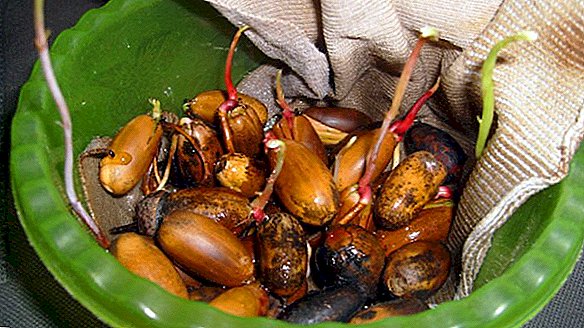
Such a beautiful plant as an oak will look very harmonious with yellow colors: maple, linden, acacia yellow, ash, chestnut and poplar.A little more and stronger saplings will be ready for transplanting into open ground.
Oak care
So, you have successfully coped with the task of growing a seedling and transplanted the plant to a permanent habitat at the dacha. Now your main task is to provide the young tree the right care. We emphasize that careful care of the oak requires only at first, while the plant is young, that is, up to about 5 years of age.
Do I need to water the plant
Despite the fact that the oak tree is considered to be a drought-resistant plant, in this case mature trees are meant, and young individuals require regular watering. As soon as you have planted a seedling in open ground, it should be immediately watered and continued to be watered for up to 5 days daily.
Then, in the hot season from late spring to early fall, young oak trees need to be watered systematically as the ground dries. It is important to remember that oak does not like stagnant moisture, so periodically you need to loosen the soil around the trunk and timely remove the leaves and other debris. 
Responsiveness to feed
Young animals are very sensitive to the environment, therefore, in order for the oak to take root, in the first years it is especially important to pay attention to top dressing. Usually, oak is fertilized twice per season: in early spring and in autumn, special mineral dressings in the form of pellets are used for this. It is noted that regular fertilizer increases the resistance of oaks to diseases and fungi, and also contributes to more intensive growth of young trees.
Literate pruning young oak
As is known, oak has an impressive crown, which can bring to the garden plot not only the desired coolness, but also an undesirable shade for other plants. In addition, the timely removal of dried branches gives the tree a neater look.
- pruning is usually carried out in the fall before the onset of frost or in early spring before the juice is released. Usually, excess shoots are removed, dry branches are cut off and the branches are pinched to form the crown;
- in order to give the crown a rounded shape, several branches are cut out in the central part of the crown, while the side branches are only slightly trimmed. If the oak tree has gone too far into vertical growth, it is pinned to the top (central shoot). On thick branches, after cutting off their parts, the area of the cut is painted;
- It is important to remember that young oak is better to start pruning after the trunk has been fully formed, otherwise you risk getting an oak bush instead of a tree.
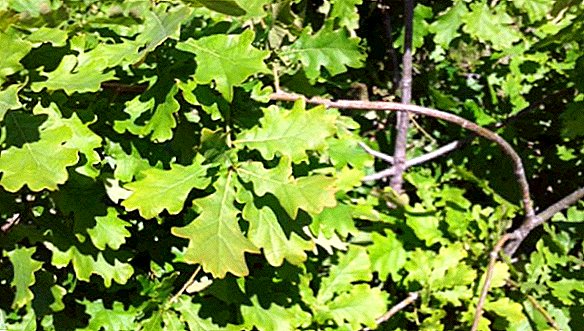
Disease and pest treatment
Oak is a very stable culture, but like other deciduous trees, it is prone to certain diseases and attracts pests:
- most often oak strikes powdery mildewforming a whitish bloom on the leaves of the tree. This fungal disease not only spoils the appearance, but also weakens the plant, in addition, it can go to the shrubs and trees adjacent to the oak. It is easiest to deal with powdery mildew by methods of prevention: it is necessary to periodically process the plant with fungicidal agents, and if the first signs of the disease are found, then destroy the affected branches, and spray the tree itself with a fungicide;
- dropsy. This disease occurs in oak trees due to the ingress of pathogenic bacteria under the bark. As a result of the development of the disease, swelling under the cortex forms, filled with liquid, then the dropsy is opened and leaves cracks and stains on the bark. The disease occurs after adverse weather conditions: extreme heat or cold snap. In order to avoid dropsy, you need to carefully monitor the branches and crown, remove dry branches, leaves, cut wild shoots;
- rot caused by mushroomsthat develop directly in wood and even roots. Typically, these mushrooms live on dead trees, but there are species that infect and live plants and lead to shrinkage and destruction of these, such mushrooms include root sponge, tinder oak. For the prevention of rot, it is necessary to observe the agrotechnology of growing the tree, timely cutting and cleaning of dried branches, protect the tree from rodents, in order to preserve the integrity of the bark and prevent spores from getting inside;
- gall midges- the most common pests. Many saw small balls around oak leaves. They have nothing to do with the fruit — these are eggs laid by these insects; the larvae stimulate the growth of tissue around them, thus forming a shelter in the form of balls (galls). The timely processing of oak with industrial pesticides will help against the attack of harmful nut-yards.
Did you know? On the inner surface of the balls contains a huge amount of tannins, which were used in the manufacture of ink, which is why the Gauls were called "ink balls".
- green oak leafworm - malicious caterpillar that devours the foliage, weakening the tree and reducing its yield. Appears in hot, humid weather. It is recommended to fight it, as well as other insects, by spraying with insecticides when the first symptoms appear.
Shelter for the winter
Несмотря на природную морозоустойчивость дуба обыкновенного, он чувствителен к резким перепадам температуры, поэтому молодые деревца хотя бы первые 1-2 года жизни лучше укрывать на зиму. For these purposes, you can use special insulation or ordinary burlap, which is wrapped with a trunk and branches. With age, the oak adapts to the cold weather, and 2-3-year-old trees will be able to tolerate them without shelter. 
Mistakes gardeners when caring for oak
The success of growing any tree, including oak, is in compliance with agrotechnics, but often novice gardeners make standard mistakes that lead to the death of a seedling or disrupt the growth of an adult and other plants.
One of them:
- wrong place selection. Oak is known to possess sprawling crown and an extensive root system. Planting it too close to other plants or objects can be harmful. Overgrown roots can harm neighboring crops, as well as damage to buildings;
- violation of landing rules. Many gardeners are in such a hurry to plant a tree in the ground that they do not pay attention to the preparation of the pit. The planting pit should be dug in advance in order for the metabolic processes necessary for the adaptation of the seedling to begin in the soil. You can not plant a tree in a newly dug hole;
Also, oak is suitable for creating an oriental-style garden, combining with thujas, spruce, elderberry and barberry.
- improper watering. Many even experienced gardeners water the plants insufficiently - this often leads to the fact that only the top layer of soil is moistened, respectively, the moisture simply does not reach deep-lying roots. It is important to take into account that for humidifying 25 centimeters of the soil layer per 1 square meter you need 25-26 liters of water;
- non-compliance with the rules for pruning branches. Many produce crown pruning strictly according to the calendar, which often leads to negative consequences for the tree. To avoid this, in addition to the calendar, you need to be guided by weather conditions, if it is too cold and frost still occurs at night, it is better to postpone trimming a bit until stable positive air temperature is established.
Reviews from the network







